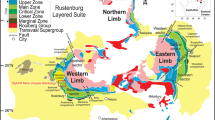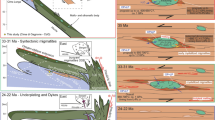Abstract
The country rock in southern Finland formed mainly during the Svecofennian orogeny ca. 1.9 Ga ago. The middle and lower crust was partially melted 1.83 Ga ago due to crustal thickening and subsequent extension. During this event, S-type migmatites and granites were formed along a 100×500 km zone. This Late Svecofennian Granite–Migmatite zone (LSGM zone) is a large crustal segment characterised by roughly E–W trending sub-horizontal migmatites and granites. Combined ductile E–W shear movements and NNW–SSE compressional movements defined a transpressional tectonic regime during the emplacement. Partial melts that moved through the crust pooled as granite sheets or froze as migmatites. Major transpressive shear zones border the LSGM zone, which forms a tectonic and metamorphic zone that crosscuts the earlier Svecofennian granitoids. Based on field observations and geochemical data from two sets of outcrops, we show that the great volumes of late-orogenic granites and migmatites in southern Finland were transported and emplaced as small chemically variable batches, possibly extracted from different protoliths. These melt batches were transported along repeatedly activated channels and collected at some horizontal level in the crust. In the Nagu area, the melt batches were trapped under a roof-layer of amphibolite and the whole complex was synchronously folded into open folds with steep axial surfaces and E–W trending fold axes. The sheets of microcline granite are, in places, strongly sheared; the microcline phenocrysts are imbricated and subsequent deformation of the microcline phenocrysts indicates syn-tectonic movements of the layers as well as a syn-tectonic mechanism for the late-magmatic fractionation. Depending on the degree of crystallisation of the individual melt batches during shearing at different intensities, the granites have slightly different appearances. Some sheared zones show a cumulate-like trace element geochemistry, indicating that melt fractions were expelled from the system, producing layers of deformation enhanced fractionated granites and cumulate layers. Our interpretation is that the Nagu area shows shear-assisted fractionation mechanisms in granitic melts, and that similar processes are responsible for the fractionation trends seen in the sub-horizontal sheeted granites in Hämeenlinna at higher levels in the crust.

















Similar content being viewed by others
References
Arzi AA (1978) Critical phenomena in the rheology of partially melted rocks. Tectonophysics 44:173–184
Brown M, Solar G (1998a) Granite ascent and emplacement during contractional deformation in convergent orogens. J Struct Geol 20(9–10):1365–1393
Brown M, Solar G (1998b) Shear-zone systems and melts; feedback relations and self-organization in orogenic belts. J Struct Geol 20(2–3):211–227
Clemens JD (2003) S-type granitic magmas—petrogenetic issues, models and evidence. Earth-Sci Rev 61:1–18
Ehlers C, Lindroos A (1990) Low angle ductile shears in the Early Proterozoic rocks of SW Finland. Geol Fören Stockholm Förh 112:177–178
Ehlers C, Lindroos A, Selonen O (1993) The late Svecofennian granite–migmatite zone of southern Finland—a belt of transpressive deformation and granite emplacement. Precambrian Res 64:295–309
Eskola P (1914) On the petrology of the Orijärvi region in southwestern Finland. Bulletin de la Comission Géologique de Finlande 40:277
Huhma H (1986) Sm-Nd, U-Pb and Pb-Pb isotopic evidence for the origin of the early Proterozoic Svecokarelian crust in Finland. Geol Surv Finl Bull 337:48
Johannes W, Ehlers C, Kriegsman LM, Mengel K (2003) The link between migmatites and S-type granites in the Turku area, southern Finland. Lithos 68:69–90
Korsman K, Hölttä P, Hautala T, Wasenius P (1984) Metamorphism as an indicator of evolution and structure of the crust in eastern Finland. Geol Surv Finl Bull 328:1–38
Luosto U (1997) Structure of the Earth’s crust in Fennoscandia as revealed from refraction and wide-angle reflection studies. Geophysica 33(1):3–16
Maaløe S (1982) Geochemical aspects of permeability controlled partial melting and fractional crystallisation. Geochim Cosmochim Acta 46:43–57
Miller CF, Watson EB, Harrison TM (1988) Perspectives on the source, segregation and transport of granitoid magmas. Trans R Soc Edinburgh: Earth Sciences 79:135–156
van der Molen I, Paterson MS (1979) Experimental deformation of partially melted granite. Contrib Mineral Petrol 98:299–318
Nironen M (1997) The Svecofennian orogen: a tectonic model. Precambrian Res 86:21–44
Nurmi PA, Haapala I (1986) The Proterozoic granitoids of Finland: granite types, metallogeny and relation to crustal evolution. Bull Geol Soc Finland 58(1):203–233
Rollinson H (1993) Using geochemical data: evaluation, presentation, interpretation. Addison Wesley Longman group Ltd UK, 352 pp
Sawyer EW (1991) Disequilibrium melting and the rate of melt-residuum separation during migmatization of mafic rocks from the Grenville front, Quebec. J Petrol 32:701–738
Sederholm JJ (1932) On the geology of Fennoscandia with special reference to the Precambrian. Bulletin de la Comission Géologique de Finlande 98:35
Sederholm JJ (1934) On migmatites and associated pre-cambrian rocks of southwestern Finland Part III The Åland Islands. Bulletin de la Comission Géologique de Finlande 107:68
Seitsaari J (1955) Geological map of Finland 1:100 000. Pre-Quaternary rocks Sheet 2012 Perniö Geological Survey of Finland Helsinki
Selonen O, Ehlers C, Lindroos A (1996) Structural features and emplacement of the late Svecofennian Perniö granite sheet in southern Finland. Bull Geol Soc Finland 68(part 2):5–17
Stålfors T, Ehlers C (2000a) Emplacement mechanisms of late-orogenic granites. In: Southern Finland 24th Nordic Geological Wintermeeting, Trondheim, Norway Geonytt 1:164
Stålfors T, Ehlers C (2000b) Granite emplacement during the 1.83 Ga late-orogenic stages in southern Finland. In Pesonen LJ, Korja A, Hjelt, S-E (eds) Lithosphere 2000, a symposium on the structure, composition and evolution of the lithosphere in Finland. Institute of Seismology, Univ of Helsinki, report S-41: 91–96
Stålfors T, Ehlers C (2001) Granitic plutons composed of small melt batches – examples from Proterozoic rocks in southern Finland EUG XI European Union of Geosciences. J Conf Abstr 6(1): 584
Stålfors T, Ehlers C (2003) Emplacement and fractionation of Proterozoic magmas related to shearing, south western Finland. Fifth Hutton Symposium: The origin of granites and related rocks. Toyohashi Japan Geological Society of Japan, Interim-Report 29: 141
Suominen V (1991) The chronostratigraphy of southwestern Finland with special reference to Postjotnian and Subjotnian diabases. Geol Surv Finl Bull 356:100
Watson EB, Harrison TM (1983) Zircon saturation revisited: temperature and composition effects in variety of crustal magma types. Earth Planet Sci Lett 64:295–304
Väisänen M, Hölttä P (1999) Structural and metamorphic evolution of the Turku migmatite complex, southwestern Finland. Bull Geol Soc Finland 71(part 1):177–218
Acknowledgements
This work was funded by Outokumpu foundation and the Academy of Finland. We are grateful to late Professor Nils Edelman for providing us with information on the outcrops in the Nagu area. Denis Gapais and Håkan Sjöström are greatly acknowledged for fruitful discussions at the outcrops. We also wish to thank Kurt Mengel and Håkan Sjöström for their constructive reviews of this manuscript.
Author information
Authors and Affiliations
Corresponding author
Rights and permissions
About this article
Cite this article
Stålfors, T., Ehlers, C. Emplacement mechanisms of late-orogenic granites: structural and geochemical evidence from southern Finland. Int J Earth Sci (Geol Rundsch) 95, 557–568 (2006). https://doi.org/10.1007/s00531-005-0049-3
Received:
Accepted:
Published:
Issue Date:
DOI: https://doi.org/10.1007/s00531-005-0049-3




